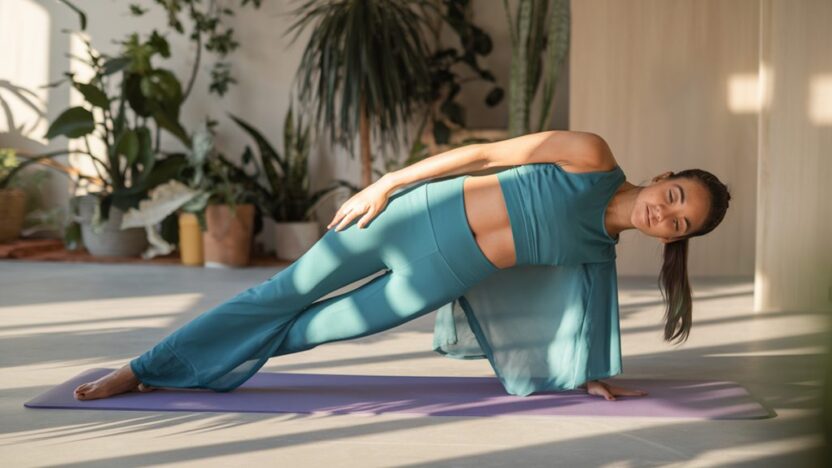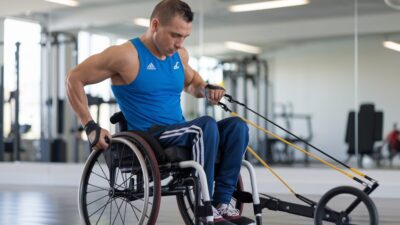Mind-body exercises like yoga and Pilates can transform your fitness journey by connecting physical movement with mental focus. You'll experience reduced stress, improved emotional well-being, and enhanced body awareness through controlled breathing and precise movements. These practices emphasize core strength, proper alignment, and mindful shifts that build both physical and mental resilience. Whether you're a beginner or experienced practitioner, you'll need minimal equipment: a non-slip mat, comfortable clothing, and a quiet space to start. Creating a consistent routine, even for just 15 minutes daily, will help you access the full spectrum of benefits these powerful practices offer.
Benefits for Mental Wellness
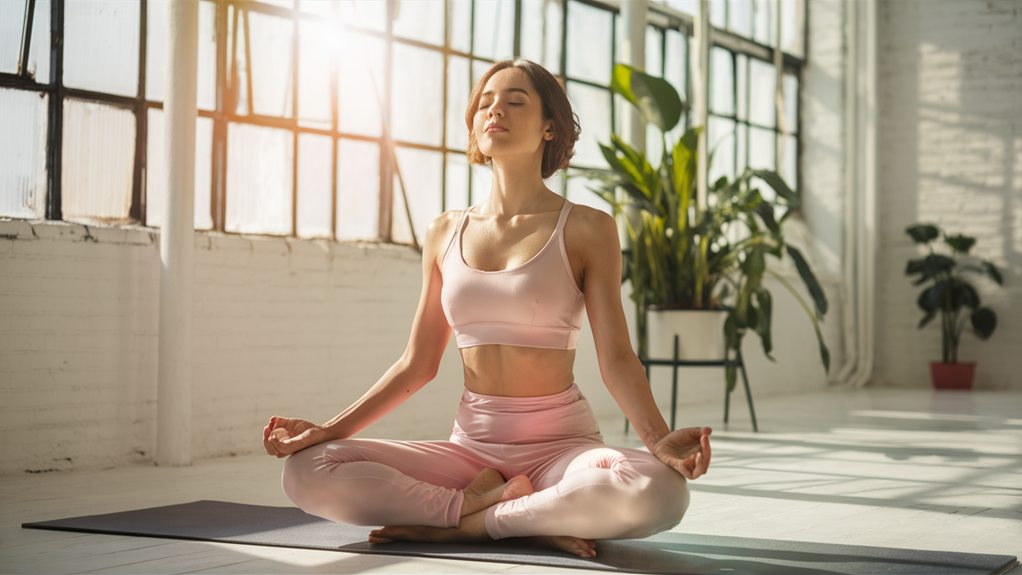
The mental wellness benefits of yoga and pilates extend far beyond the physical practice. When you engage in these mind-body exercises, you'll notice improvements in your stress levels, anxiety management, and overall emotional well-being. Through controlled breathing and mindful movements, you're developing a stronger mind-body connection that helps you stay present and focused throughout your day.
Additionally, these practices enhance your core strength and flexibility, which are essential for overall physical health, contributing to a more balanced state of mind the mental benefits of yoga and pilates.
During your practice, you'll learn to quiet your racing thoughts and concentrate on the sensations in your body, which can greatly reduce mental clutter and worry. These exercises teach you valuable meditation techniques that you can use both on and off the mat, helping you handle life's challenges with greater ease.
You'll develop better emotional regulation skills, improved self-awareness, and enhanced mental clarity. Regular practice strengthens your ability to stay calm under pressure, as you're training your mind to maintain focus even during challenging poses or movements.
The mindfulness skills you'll gain through yoga and pilates can boost your mood, improve your sleep quality, and help you maintain a more positive outlook on life, making these practices powerful tools for mental health maintenance.
Core Principles and Practices
Building upon these mental wellness benefits, understanding the fundamental principles of yoga and pilates empowers you to practice effectively and safely.
Both disciplines share common core elements that you'll need to master, including proper breathing techniques, body alignment, and mindful movement patterns. Engaging in these practices can greatly enhance your flexibility and overall well-being, as highlighted in the benefits of yoga and pilates.
When you're starting your practice, focus on these essential principles that build strength and create a solid foundation:
- Breath Control – You'll learn to coordinate your movements with your breath, using deep inhales and exhales to power your practice and maintain focus.
- Center of Gravity – Both practices emphasize engaging your core muscles, which serve as your body's powerhouse for stability and strength.
- Precise Alignment – You'll discover how to position your body correctly, ensuring each movement supports proper form and prevents injury.
- Mindful Movement – You're encouraged to move with intention, connecting your mind to each action while maintaining awareness of your body's signals.
These foundational elements work together to create a practice that's both challenging and rewarding, helping you develop physical control while maintaining a mind-body connection that supports your overall wellness journey.
Getting Started With Classes
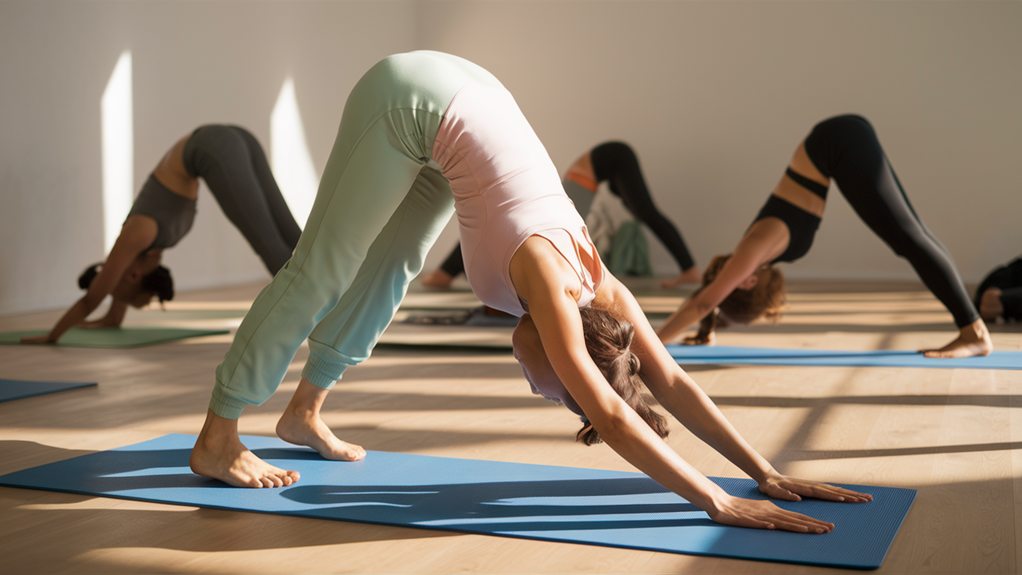
Starting your journey into yoga or pilates classes requires careful consideration of several key factors. You'll want to research different studios in your area, read reviews, and understand their teaching styles before committing to any classes.
It's important to recognize the benefits of these practices, as they can greatly enhance your flexibility, core strength, and overall mental wellness, contributing to stress reduction the benefits of yoga and Pilates. When selecting a class, consider your current flexibility and fitness level to make certain you're choosing an appropriate difficulty level for beginners.
Begin with introductory or foundation classes, which will help you learn proper form and basic movements. Most studios offer special packages for new students, allowing you to try different instructors and class times.
You'll need comfortable, breathable clothing that allows for movement, and you might want to invest in your own mat for hygiene purposes.
Don't hesitate to communicate with your instructor about any physical limitations or concerns you may have. They're there to support your journey and can provide modifications to help you succeed.
Remember to arrive at least 10-15 minutes early for your first class to complete any necessary paperwork and familiarize yourself with the studio's layout and policies. Starting slowly and being consistent will help you build a strong foundation for your practice.
Equipment and Space Requirements
Creating a dedicated practice space for yoga or Pilates requires minimal investment and thoughtful setup. You'll want to carve out an area that's calm, well-ventilated, and free from distractions, where you can fully focus on your practice.
Different yoga styles, such as Vinyasa and Hatha, offer unique benefits that can enhance your overall experience. Whether it's a corner of your bedroom or a spot in your living room, ascertain there's enough space to stretch your arms and legs fully without bumping into furniture.
For a complete home practice setup, you'll need these essential items:
- A high-quality, non-slip yoga mat that provides proper cushioning and grip for your poses
- Two yoga blocks to support proper alignment and help you maintain balance in challenging positions
- A yoga strap or belt to assist with flexibility and reaching difficult poses
- A blanket or bolster for meditation and restorative poses
When you're selecting your practice area, make certain you've got at least 6 feet by 6 feet of clear floor space.
If you're practicing online classes, you'll want to position yourself so you can easily see your screen while maintaining proper form on your mat. Good lighting is essential, and you might want to take into account adding some calming elements like plants or soft lighting.
Building a Daily Routine
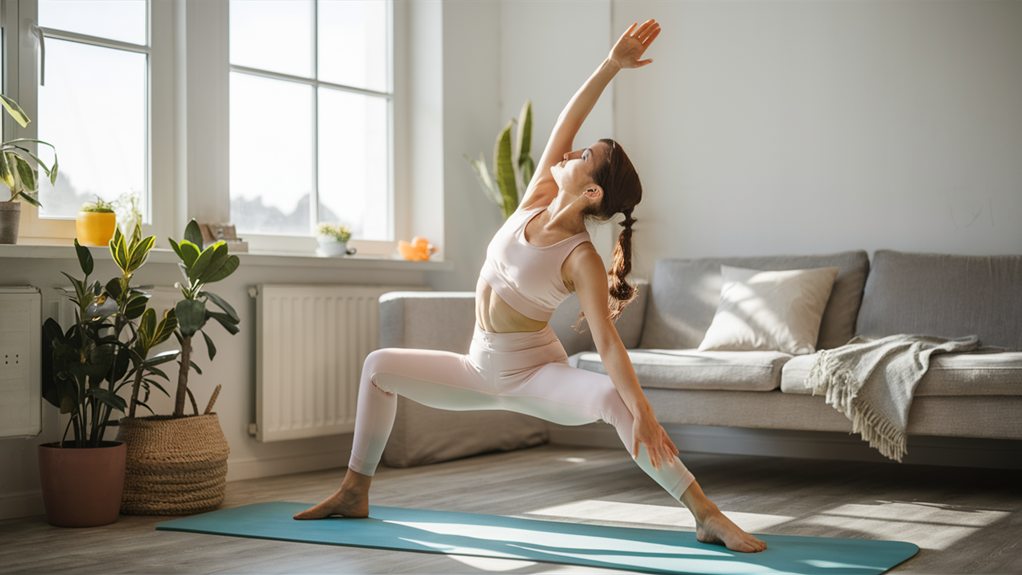
For successful mind-body practice, consistency matters more than duration. You'll benefit more from doing 15 minutes daily than from a single hour-long session once a week. Start by choosing a specific time of day when you're most likely to stick with your routine, whether it's early morning before work or during your lunch break. Engaging in these exercises can also enhance social interaction, making it a wonderful activity to share with family members, fostering motivation and connection through shared exercise.
Begin by setting realistic goals that fit your schedule, and don't be afraid to break your practice into smaller segments. You might do a 10-minute yoga flow in the morning and a quick Pilates core workout in the evening.
As you build your routine, focus on key fundamentals like proper breathing techniques and alignment before advancing to more complex moves.
Keep a practice journal to track your progress, noting which exercises feel challenging and which ones energize you most. It's perfectly fine to modify your routine based on how your body feels each day.
Remember to include both standing and mat-based exercises, and alternate between yoga and Pilates sessions to work different muscle groups. Over time, you'll naturally find your rhythm and develop a sustainable practice that serves your mind and body.
